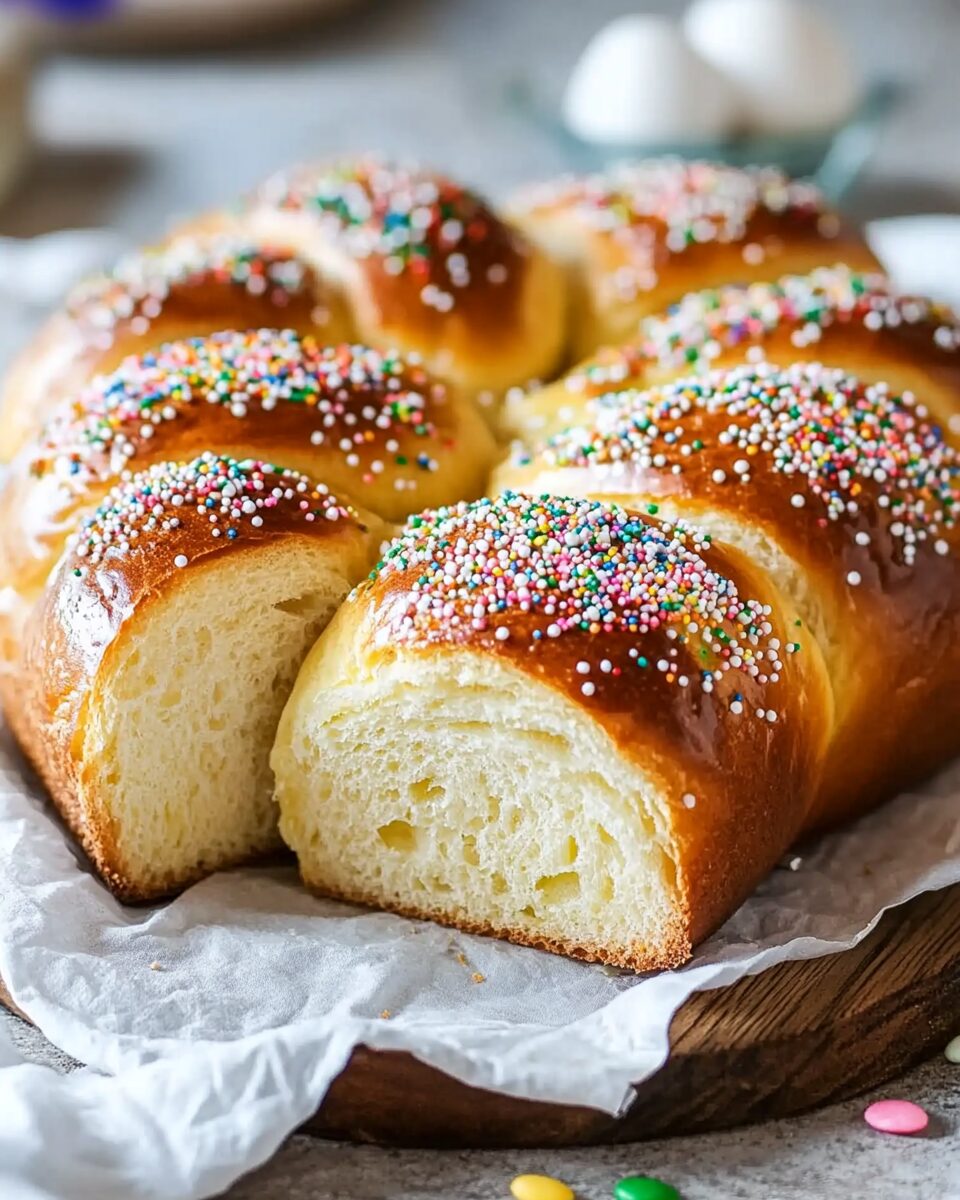Sweet Italian Easter Bread, or Pan di Pasqua, is a traditional brioche-like bread enjoyed during the Easter holiday. This slightly dense, sweetened bread boasts a citrusy flavor and is often adorned with festive sprinkles, making it a delightful treat for family and friends.
Full Recipe:
Ingredients
- 1 cup whole milk (3% fat)
- ½ cup butter
- 8 grams instant dry yeast
- 1 cup granulated sugar
- 1 teaspoon salt
- 4 large eggs, room temperature
- Zest of 1 medium lemon
- Zest of 1 large orange
- 5½ cups all-purpose flour
- Rainbow sprinkles
- Sugar granules
For the egg wash:
- 1 large egg
- 1 tablespoon milk
Directions
- Heat the milk and butter in a small saucepan, stirring until the butter melts and the mixture reaches about 110°F (43°C). Set aside.
- In the bowl of a stand mixer, combine sugar, yeast, and salt.
- Using the paddle attachment, mix in the lightly beaten eggs.
- Add the milk and butter mixture to the bowl and mix until combined.
- Incorporate the lemon and orange zest, then sift in two cups of flour. Mix well for about 2 minutes.
- Switch to the dough hook attachment and gradually add the remaining flour, mixing continuously. Knead the dough for 10 to 12 minutes; it should be slightly sticky—avoid adding extra flour.
- Lightly flour your hands and transfer the dough to a floured work surface. Knead for one minute to form a cohesive ball, then place it in a greased bowl.
- Cover the bowl with plastic wrap and let the dough rise until doubled in size, approximately 1½ hours.
- Transfer the risen dough to a lightly floured cutting board and divide it into three equal portions.
- Roll each portion into a rope measuring 27 to 28 inches (68-71 cm) in length.
- Place the ropes side by side on a parchment-lined baking sheet and pinch the top ends together.
- Braid the three strands and pinch the bottom ends to seal.
- Form the braided dough into a wreath by bringing the ends together and pinching to seal. Cover loosely with plastic wrap and let it rise in a warm place until doubled in size, about 1½ hours.
- Preheat the oven to 350°F (175°C).
- Prepare the egg wash by beating one egg with a tablespoon of milk. Gently brush the risen dough with the egg wash.
- Immediately sprinkle the top with rainbow sprinkles and sugar granules, if desired.
- Bake for 25 to 30 minutes, or until the bread achieves a deep golden brown color.
- Transfer the baked bread to a wire rack to cool before slicing and serving.
Nutrients (Per Serving)
- Calories: 385 kcal
- Carbohydrates: 62 g
- Protein: 10 g
- Fat: 11 g
- Saturated Fat: 6 g
- Polyunsaturated Fat: 1 g
- Monounsaturated Fat: 3 g
- Trans Fat: 0.3 g
- Cholesterol: 100 mg
- Sodium: 294 mg
- Potassium: 131 mg
- Fiber: 2 g
- Sugar: 18 g
- Vitamin A: 384 IU
- Vitamin C: 0.002 mg
- Calcium: 50 mg
- Iron: 3 mg
The Origins of Sweet Italian Easter Bread
The roots of Sweet Italian Easter Bread trace back to the Italian regions where it’s often baked to celebrate the end of Lent and the joy of the Easter season. In Italy, Easter is marked by various food traditions, with bread playing a central role. Pan di Pasqua is particularly significant because it symbolizes rebirth, renewal, and the joy of spring, making it the perfect way to celebrate the resurrection of Christ.
This bread was traditionally made with simple ingredients that were readily available to home bakers—yeast, flour, sugar, butter, and eggs—ingredients that were typically forbidden during the fasting period of Lent. By baking this bread for Easter, families would not only celebrate the end of Lent but also symbolize the end of fasting and the beginning of a joyous time with an abundance of food.
The Key Ingredients that Make This Bread Special
The key ingredients in Sweet Italian Easter Bread are not only what give it its delicious flavor but also contribute to the bread’s distinct texture and appearance.
-
Yeast: Yeast is essential in making the bread rise, creating the soft, airy texture that is characteristic of brioche-like breads. The yeast fermentation process provides the bread with its signature fluffiness.
-
Citrus Zest: The inclusion of lemon and orange zest in this bread infuses it with a refreshing, citrusy aroma and taste. The zest adds just the right balance to the sweetness of the bread and enhances its overall flavor profile. It also reflects the vibrancy of the spring season, making it a festive addition.
-
Rainbow Sprinkles and Sugar Granules: These vibrant toppings add not only a sweet crunch but also a fun, colorful touch that makes the bread visually striking. They are often associated with Easter, bringing cheer to the bread’s presentation and making it a perfect dessert for holiday gatherings.
-
Butter and Milk: These two ingredients give the bread its rich, moist, and tender crumb. The butter adds a creamy texture, while the milk helps keep the bread soft and adds to the overall flavor.
-
Eggs: Eggs provide structure to the dough, helping to hold everything together while adding richness to the bread. They also contribute to the golden color of the loaf once baked, creating a beautiful, inviting appearance.
The Art of Making Sweet Italian Easter Bread
Making Sweet Italian Easter Bread from scratch is a rewarding process that requires time and patience, but the results are well worth the effort. The preparation involves making a yeast dough, which requires careful handling to ensure the yeast works effectively. It’s essential to allow the dough to rise properly, as this is what will give the bread its light and airy texture.
The bread is shaped into a braid, which is then formed into a wreath. This wreath shape is symbolic of eternity, representing the never-ending cycle of life, and is often seen in various holiday breads around the world. The traditional practice of braiding the dough not only adds to the bread’s aesthetic appeal but also ensures that the bread bakes evenly.
Once the bread is shaped and allowed to rise for the second time, it’s brushed with an egg wash, which gives the bread a glossy, golden-brown finish when baked. Sprinkles and sugar are added on top, giving the bread its colorful and festive appearance. The bread is then baked to perfection, resulting in a warm, inviting aroma that fills the kitchen and hints at the delicious treat to come.
Sweet Italian Easter Bread: A Versatile Treat
While traditionally enjoyed as a dessert for Easter, Sweet Italian Easter Bread is incredibly versatile and can be served in many ways. It can be sliced and served with butter or fruit preserves as part of a breakfast spread. Alternatively, it can be enjoyed as an afternoon snack, paired with a cup of tea or coffee.
This bread also makes an excellent addition to any holiday meal, whether it’s served alongside a light salad or as part of a larger spread. The subtle sweetness of the bread and its citrus undertones make it a wonderful accompaniment to rich main courses, as it provides a lovely balance of flavors.
For those who enjoy creative twists on classic recipes, Sweet Italian Easter Bread can also be transformed into a delicious dessert by serving it with whipped cream, fresh fruit, or even a scoop of ice cream. The bread’s flavor lends itself well to both simple and decadent pairings, making it a perfect option for various occasions.
Making Sweet Italian Easter Bread Your Own
While this traditional recipe is delightful on its own, there’s room for creativity and customization. Here are a few ideas for making Sweet Italian Easter Bread your own:
-
Add Chocolate Chips: For a sweeter, richer experience, fold in some chocolate chips or chopped dark chocolate into the dough before baking. The chocolate will melt into the bread as it bakes, adding pockets of gooey sweetness.
-
Incorporate Dried Fruit: Consider adding dried fruit, such as raisins, cranberries, or apricots, for an extra burst of flavor and texture. The dried fruit pairs beautifully with the citrus zest and adds a lovely contrast to the bread’s softness.
-
Use Flavored Extracts: If you want to add a twist, experiment with flavored extracts like almond or vanilla to give the bread a unique depth of flavor.
-
Shape Variations: While the traditional wreath shape is iconic, feel free to get creative with different shapes. You can form the dough into loaves, braids, or even smaller individual rolls for serving.
Conclusion: A Timeless Tradition
Sweet Italian Easter Bread is more than just a dessert; it’s a symbol of family, tradition, and celebration. Its rich history, delightful flavor, and festive appearance make it a perfect choice for any special occasion, particularly Easter. Whether enjoyed as a breakfast, dessert, or snack, this bread brings joy and comfort to the table.
The combination of citrus zest, buttery dough, and festive sprinkles makes Sweet Italian Easter Bread not only a treat for the taste buds but also a feast for the eyes. Its simplicity and versatility allow it to be easily adapted to suit any occasion, while still maintaining the integrity of its traditional roots.
By following this recipe and bringing Sweet Italian Easter Bread to life in your own kitchen, you’re not only preparing a delicious treat but also connecting with a centuries-old tradition that continues to bring people together. So, whether you’re baking it for Easter or any other occasion, this bread is sure to become a cherished addition to your family’s recipe collection.






